Machine Learning-Assisted Prediction of Oil Production and CO2 Storage Effect in CO2-Water-Alternating-Gas Injection (CO2-WAG)
Abstract
1. Introduction
2. Methods
2.1. CMG Base Model
2.1.1. Parameter Settings of the Base Model
2.1.2. Injection and Production Settings
2.2. Machine Learning for CO2-WAG Prediction
2.2.1. Principle of the Random Forest Regression Algorithm
2.2.2. Randomized Regression Forest Algorithm Flow
3. Results and Discussion
3.1. Base Case Analysis
3.2. Analysis of Influence Factors on CO2-WAG
3.3. Analysis of Machine Learning Results
4. Conclusions
Supplementary Materials
Author Contributions
Funding
Institutional Review Board Statement
Informed Consent Statement
Data Availability Statement
Acknowledgments
Conflicts of Interest
References
- Gao, J.; Lv, J. Problem analysis on low permeability reservoir water flooding. Inn. Mong. Petrochem. Ind. 2009, 48–51. [Google Scholar]
- Li, S.; Tang, Y. Present situation and development trend of CO2 injection enhanced oil recovery technology. Oil Gas Reserv. Eval. Dev. 2019, 9, 1–8. [Google Scholar]
- Chen, H.; Liu, X. Prospects and key scientific issues of CO2 near-miscible flooding. Pet. Sci. Bull. 2020, 3, 392–401. [Google Scholar]
- Liu, S.; Ren, B.; Agarwal, B. CO2 storage with enhanced gas recovery (CSEGR): A review of experimental and numerical studies. Pet. Sci. 2022, 19, 594–607. [Google Scholar] [CrossRef]
- Wei, Q.; Hou, J. Laboratory study of CO2 channeling characteristics in ultra-low-permeability oil reservoirs. Pet. Sci. Bull. 2019, 2, 145–153. [Google Scholar]
- Chen, Z.; Su, Y. Characteristics and mechanisms of supercritical CO2 flooding under different factors in low-permeability reservoirs. Pet. Sci. 2022, 19, 1174–1184. [Google Scholar] [CrossRef]
- Tang, R.; Wang, H. Effect of water and gas alternate injection on CO2 flooding. Fault Block Oil Gas Field 2016, 23, 358–362. [Google Scholar]
- Sanchez, N.L. Management of water alternating gas (WAG) injection projects. In Proceedings of the Latin American and Caribbean Petroleum Engineering Conference, Caracas, Venezuela, 21–23 April 1999. [Google Scholar]
- Christensen, J.R.; Stenby, E.H. Review of WAG field experience. SPE Reserv. Eval. Eng. 2001, 4, 97–106. [Google Scholar] [CrossRef]
- Rochedo, P.R.R.; Costa, I.V.L. Carbon capture potential and costs in Brazil. J. Clean. Prod. 2016, 131, 280–295. [Google Scholar] [CrossRef]
- Godoi, J.M.A.; dos Santos Matai, P.H.L. Enhanced oil recovery with carbon dioxide geosequestration: First steps at Pre-salt in Brazil. J. Pet. Explor. Prod. 2021, 11, 1429–1441. [Google Scholar] [CrossRef]
- Kengessova, A. Prediction efficiency of immiscible Water Alternating Gas Performance by LSSVM-PSO algorithms. Master’s Thesis, University of Stavanger, Stavanger, Norway, 2020. [Google Scholar]
- Mohagheghian, E.; James, L.A. Optimization of hydrocarbon water alternating gas in the Norne field: Application of evolutionary algorithms. Fuel 2018, 223, 86–98. [Google Scholar] [CrossRef]
- Bender, S.; Yilmaz, M. Full-Field Simulation and Optimization Study of Mature IWAG Injection in a Heavy Oil Carbonate Reservoir. In Proceedings of the SPE Improved Oil Recovery Symposium, Tulsa, OK, USA, 12–16 April 2014. [Google Scholar]
- Johns, R.T.; Bermudez, L. WAG optimization for gas floods above the MME. In Proceedings of the SPE Annual Technical Conference and Exhibition, Denver, CO, USA, 5–8 October 2003. [Google Scholar]
- Chen, S.; Li, H. Optimal parametric design for water-alternating-gas (WAG) process in a CO2-miscible flooding reservoir. J. Can. Pet. Technol. 2010, 49, 75–82. [Google Scholar] [CrossRef]
- Mousavi Mirkalaei, S.M.; Hosseini, S.J. Investigation of Different I-WAG Schemes Toward Optimization of Displacement Efficiency. In Proceedings of the SPE Enhanced Oil Recovery Conference, Kuala Lumpur, Malaysia, 19–21 July 2011. [Google Scholar]
- Ghaderi, S.M.; Clarkson, C.R. Evaluation of recovery performance of miscible displacement and WAG process in tight oil formations. In Proceedings of the SPE/EAGE European Unconventional Resources Conference and Exhibition, Vienna, Austria, 20–22 March 2012. [Google Scholar]
- You, J.; Ampomah, W. Assessment of Enhanced Oil Recovery and CO2 Storage Capacity Using Machine learning and Optimization Framework. In Proceedings of the SPE Europec featured at 81st EAGE Conference and Exhibition, London, England, UK, 3–6 June 2019. [Google Scholar]
- Zhou, D.; Yan, M. Optimization of a mature CO2 flood—From continuous injection to WAG. In Proceedings of the SPE Improved Oil Recovery Symposium, Tulsa, OK, USA, 14–18 April 2012. [Google Scholar]
- Rodrigues, H.; Mackay, E.; Arnold, D.; Silva, D. Optimization of CO2-WAG and Calcite Scale Management in Pre-Salt Carbonate Reservoirs. In Proceedings of the Offshore Technology Conference Brasil, Rio de Janeiro, Brazil, 29–31 October 2019. [Google Scholar]
- Min, C.; Dai, B. A Review of the Application Progress of Machine Learning in Oil and Gas Industry. J. Southwest Pet. Univ. 2020, 42, 1–15. [Google Scholar]
- He, Y.; Song, Z. Application of machine learning in hydraulic fracturing. J. China Univ. Pet. 2021, 45, 127–135. [Google Scholar]
- Bilgesu, H.I.; Al-Rashidi, A.F. An unconventional approach for drill-bit selection. In Proceedings of the SPE Middle East Oil Show, Manama, Bahrain, 17–20 March 2001. [Google Scholar]
- Leite Cristofaro, R.A.; Longhin, G.A. Artificial Intelligence Strategy Minimizes Lost Circulation Non-Productive Time in Brazilian Deep Water Pre-Salt. In Proceedings of the OTC Brasil, Rio de Janeiro, Brazil, 24–26 October 2017. [Google Scholar]
- Wang, W.; Shi, M. Joint optimization method of well location and injection-production parameters based on machine learning. J. Shenzhen Univ. 2022, 39, 126–133. [Google Scholar]
- Breiman, L. Random forests. Mach. Learn. 2001, 45, 5–32. [Google Scholar] [CrossRef]
- Feng, M.; Yan, W. Predicting Total Organic Carbon Content by Random Forest Regression Algorithm. Bull. Mineral. Petrol. Geochem. 2018, 37, 475–481. [Google Scholar]
- Zhen, Y.; Hao, M. Research of medium and long term precipitation forecasting model based on random forest. Water Resour. Power 2015, 33, 6–10. [Google Scholar]
- Wang, P.; Lu, B. Water demand prediction model based on random forests model and its application. Water Resour. Prot. 2014, 30, 34–37. [Google Scholar]
- Lv, H.; Feng, Q. A review of random forests algorithm. J. Hebei Acad. Sci. 2019, 36, 37–41. [Google Scholar]
- Du, X.; Feng, J. PM2.5 concentration prediction model based on random forest regression analysis. Telecommun. Sci. 2017, 33, 66–75. [Google Scholar]
- Zhang, Y. The Study on Reservoir Description and Remaining Oil Distribution on the 4th–6th Sandstone Beds of the Second Member in the Shahejie Formation of Tuo 28 Block in Shengtuo Oilfield; China University of Petroleum: Qingdao, China, 2017. [Google Scholar]
- Miao, C. Reservoir Description on the 1st–3rd Sandstone Beds of the Second Member in the Shahejie Formation of the Tuo 28 Block in Shengtuo Oilfield; China University of Petroleum: Qingdao, China, 2016. [Google Scholar]
- Cutler, A.; Cutler, D.R.; Stevens, J.R. Random Forests. In Ensemble Machine Learning; Zhang, C., Ma, Y., Eds.; Springer: Boston, MA, USA, 2012. [Google Scholar]
- Fang, K.; Wu, J. A Review of Technologies on Random Forests. J. Stat. Inf. 2011, 26, 32–38. [Google Scholar]
- Hillebrand, E.; Lukas, M. Bagging weak predictors. Int. J. Forecast. 2021, 37, 237–254. [Google Scholar] [CrossRef]
- Criminisi, A.; Shotton, J. (Eds.) Decision Forests for Computer Vision and Medical Image Analysis; Springer Science & Business Media: Berlin/Heidelberg, Germany, 2013. [Google Scholar]
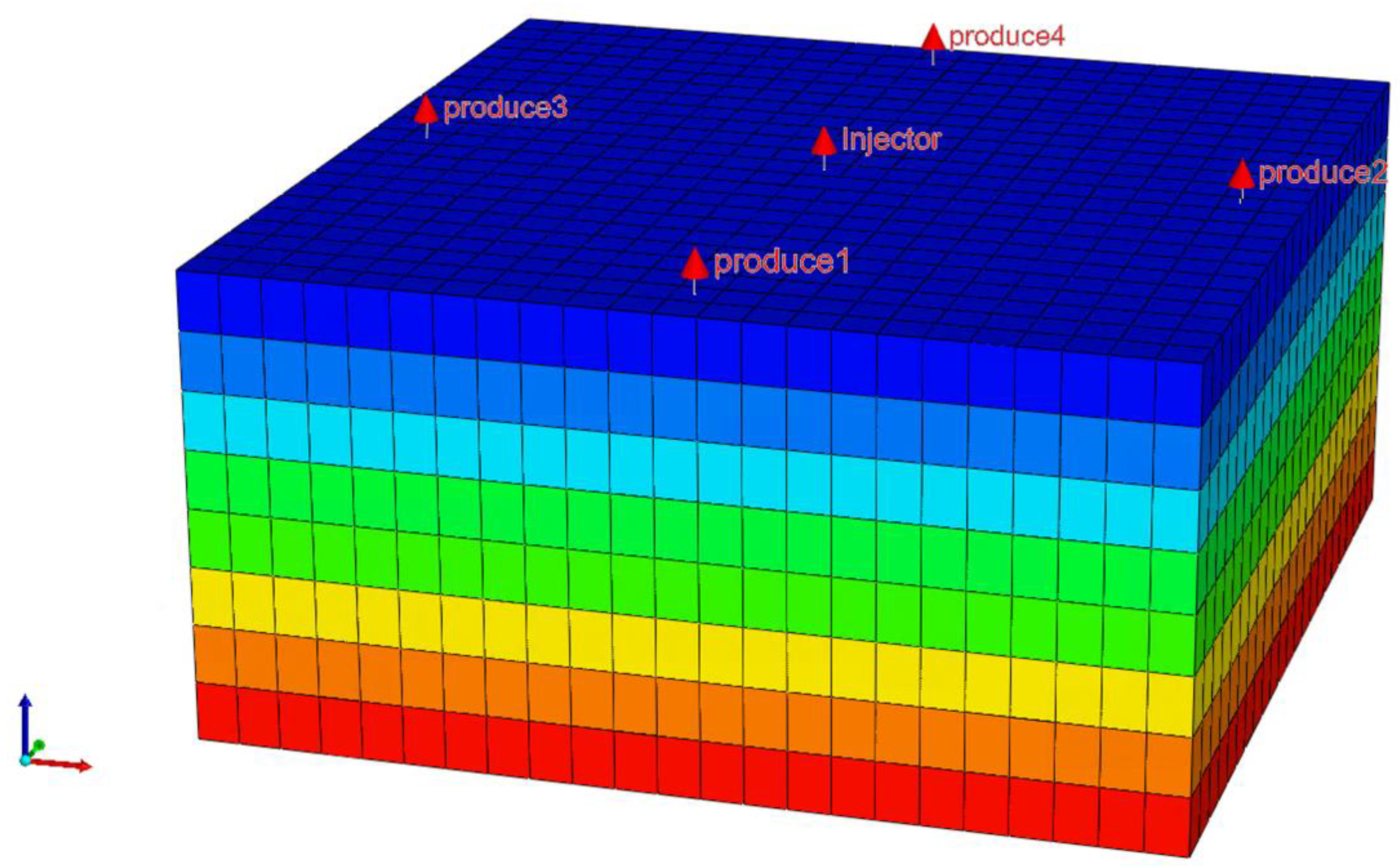
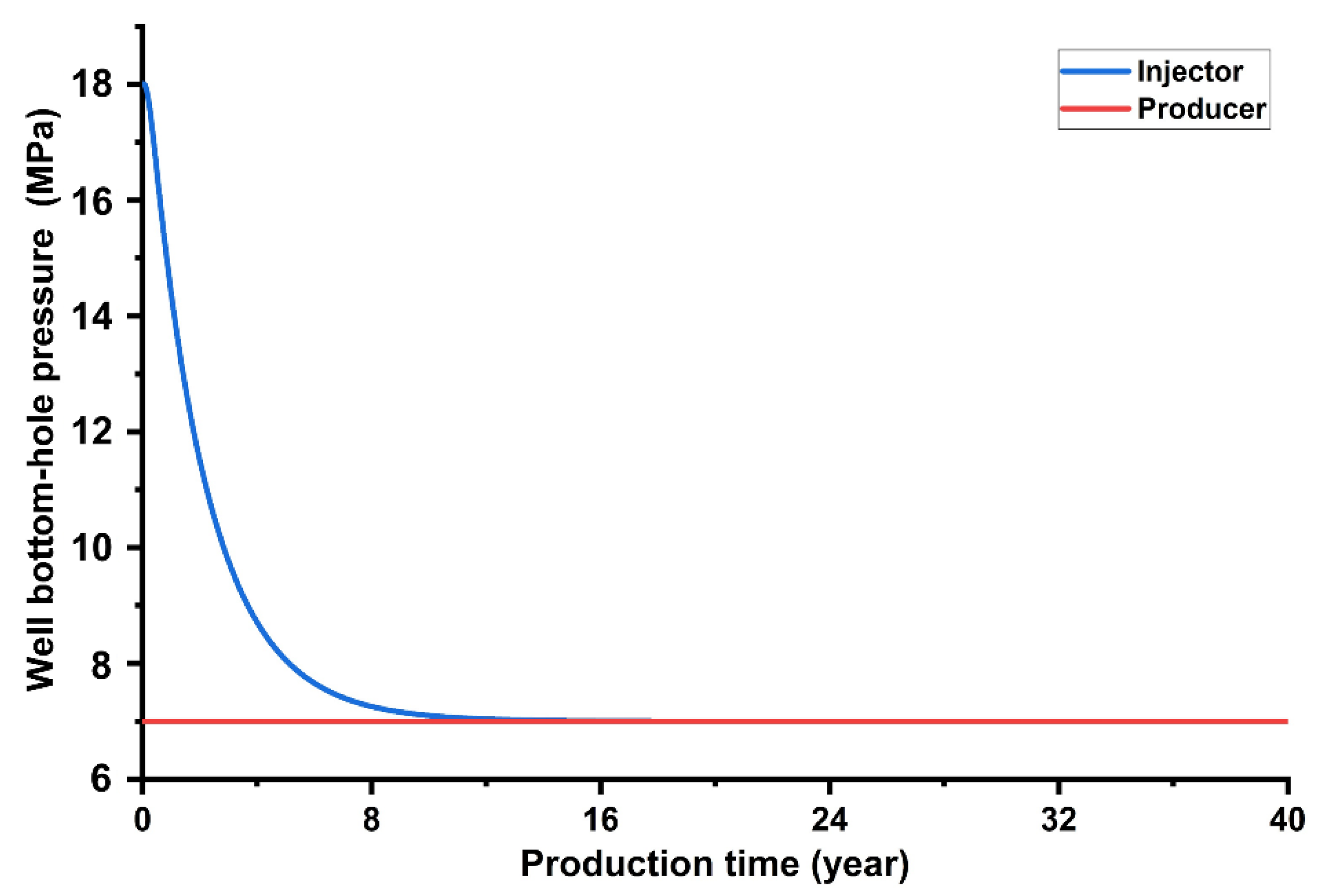
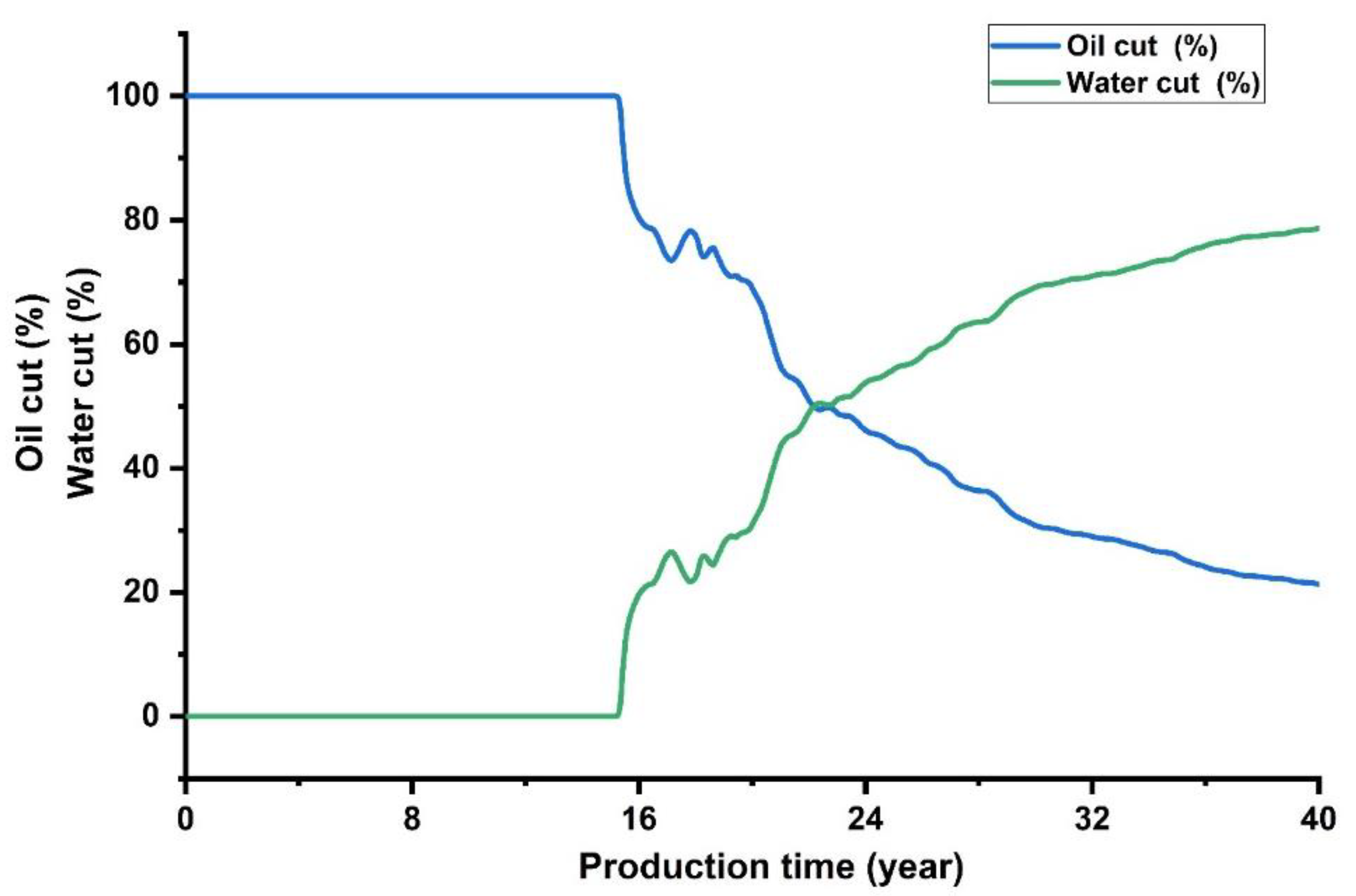
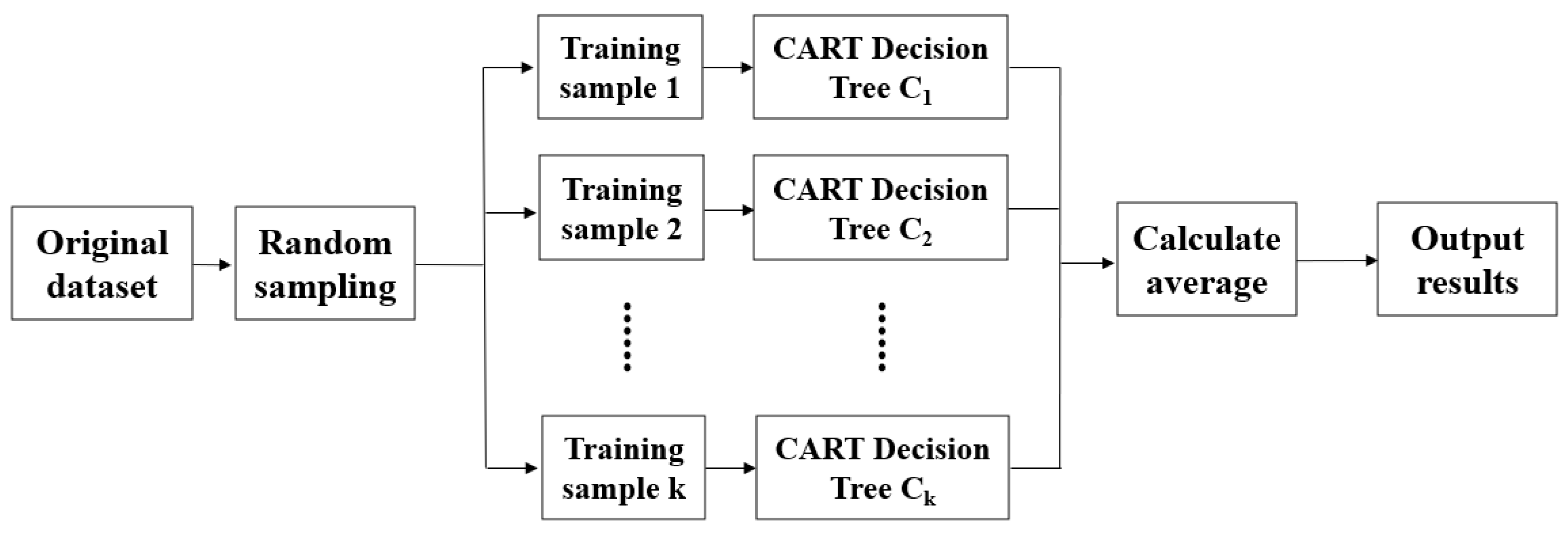
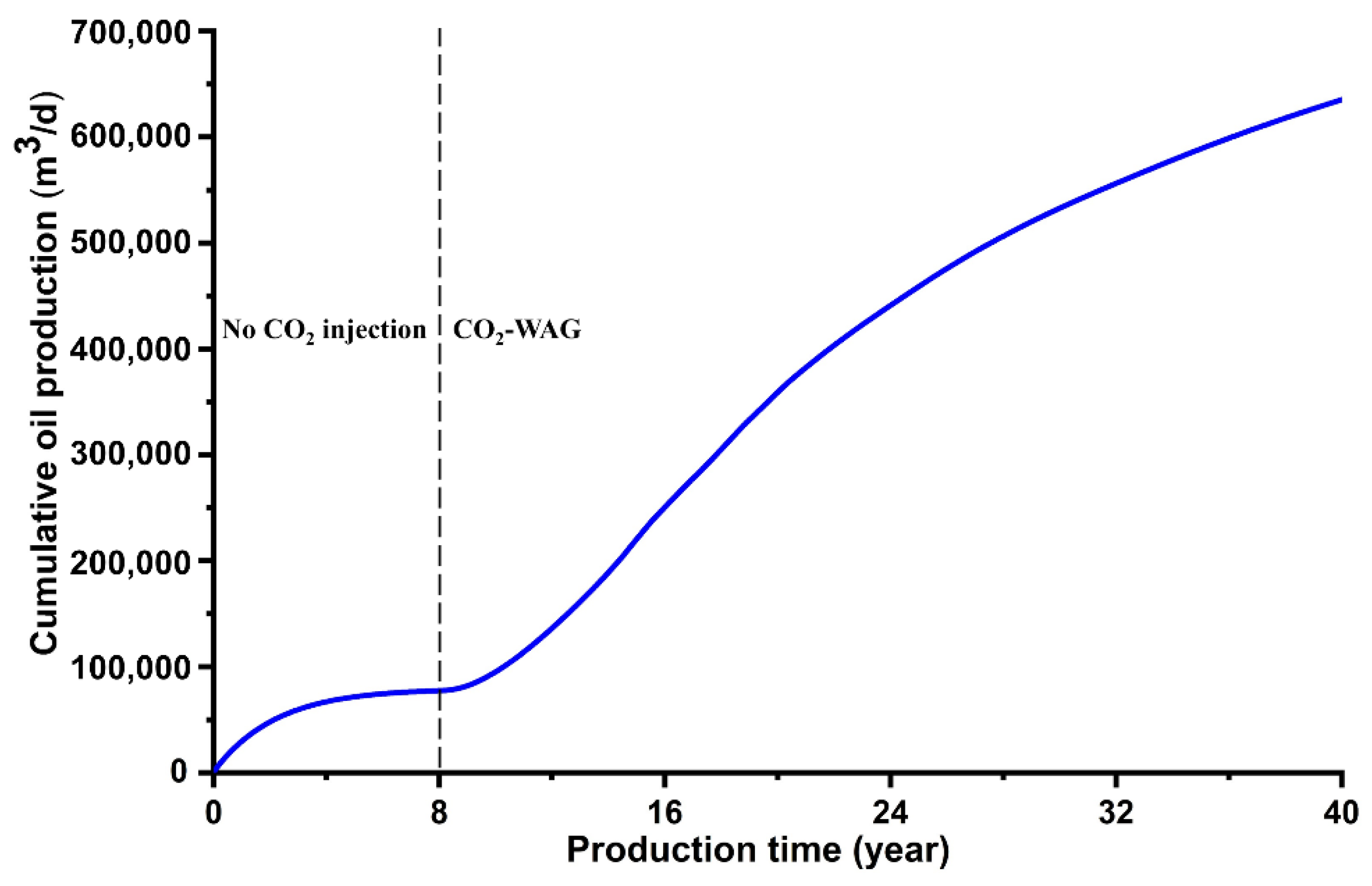
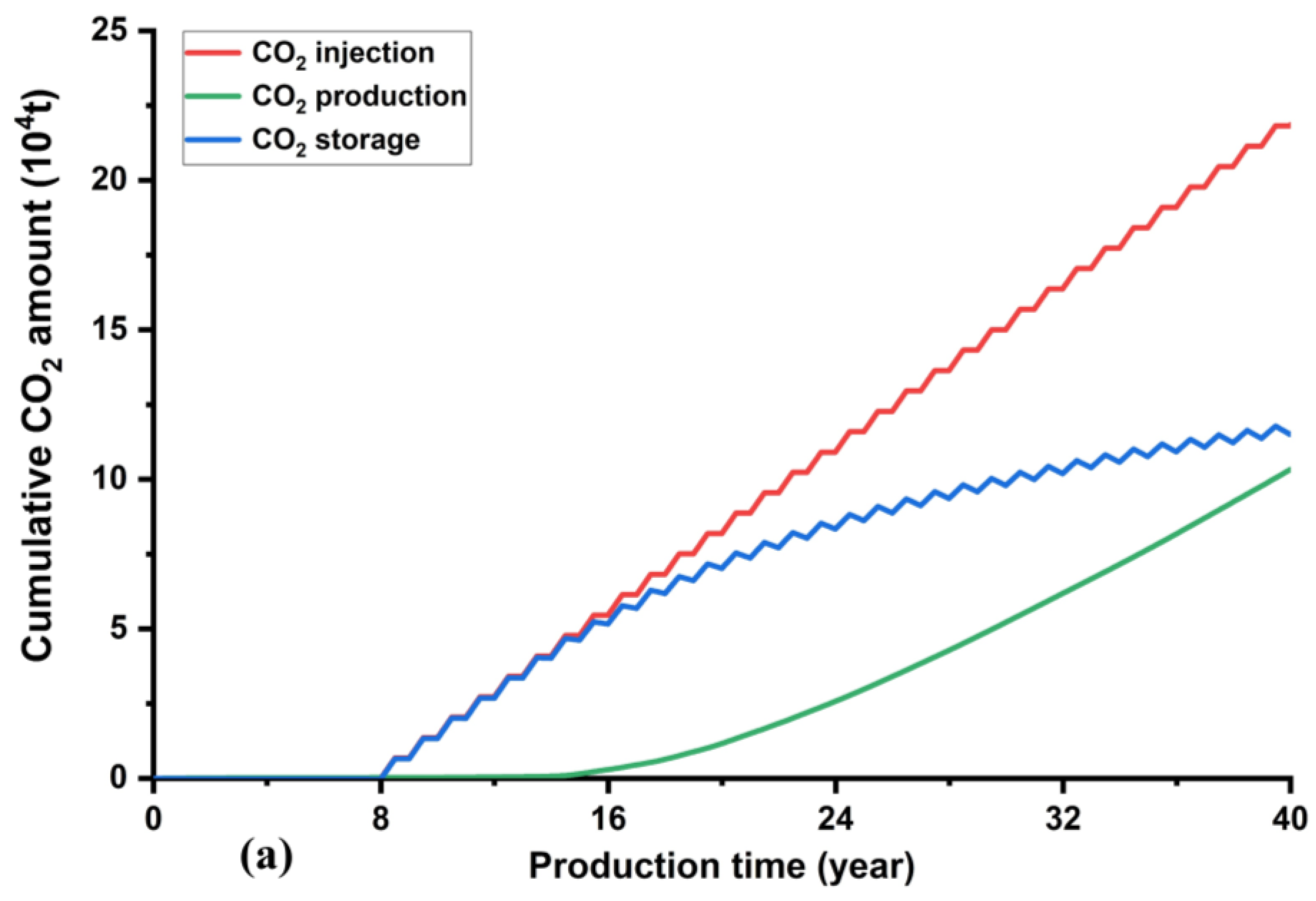
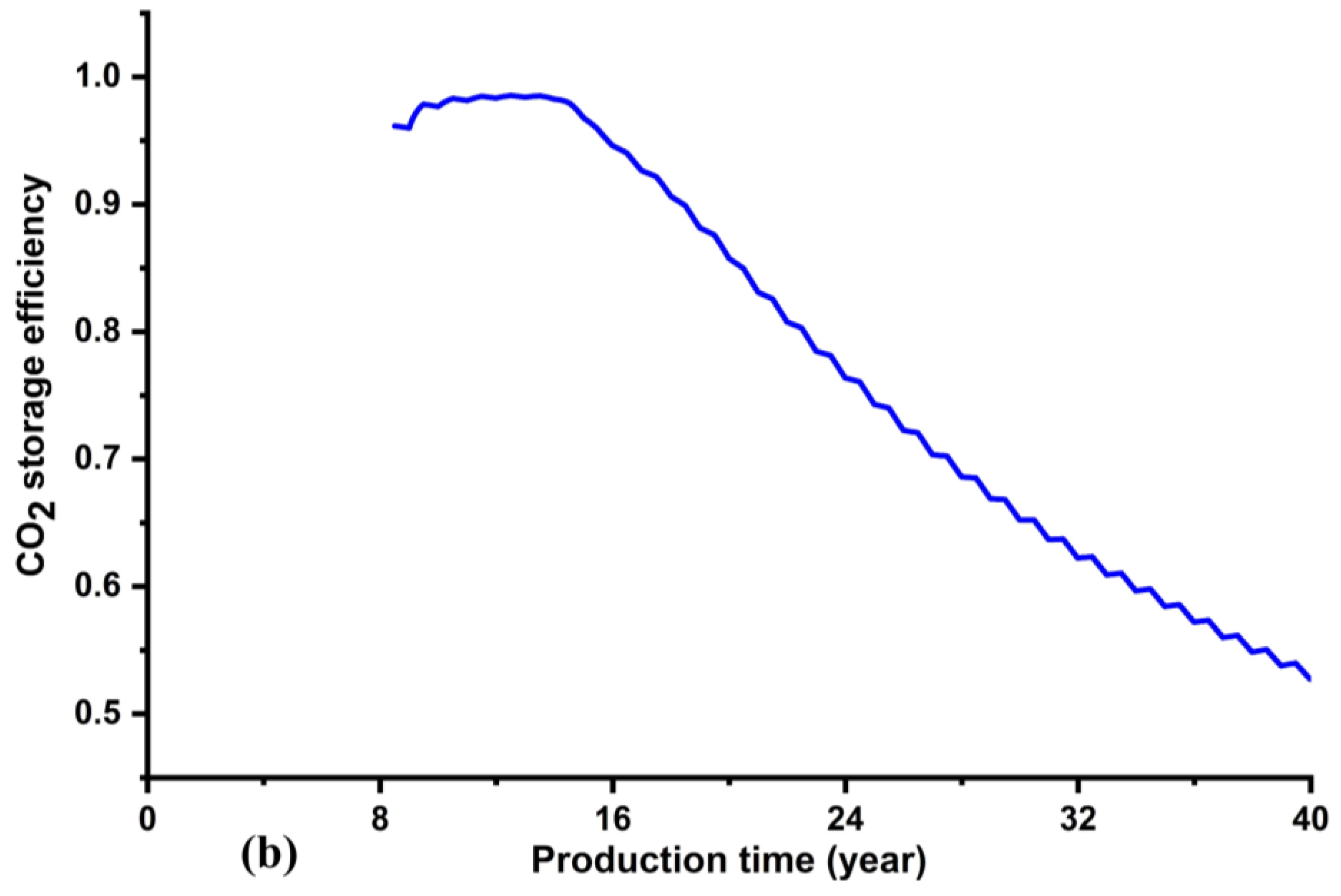
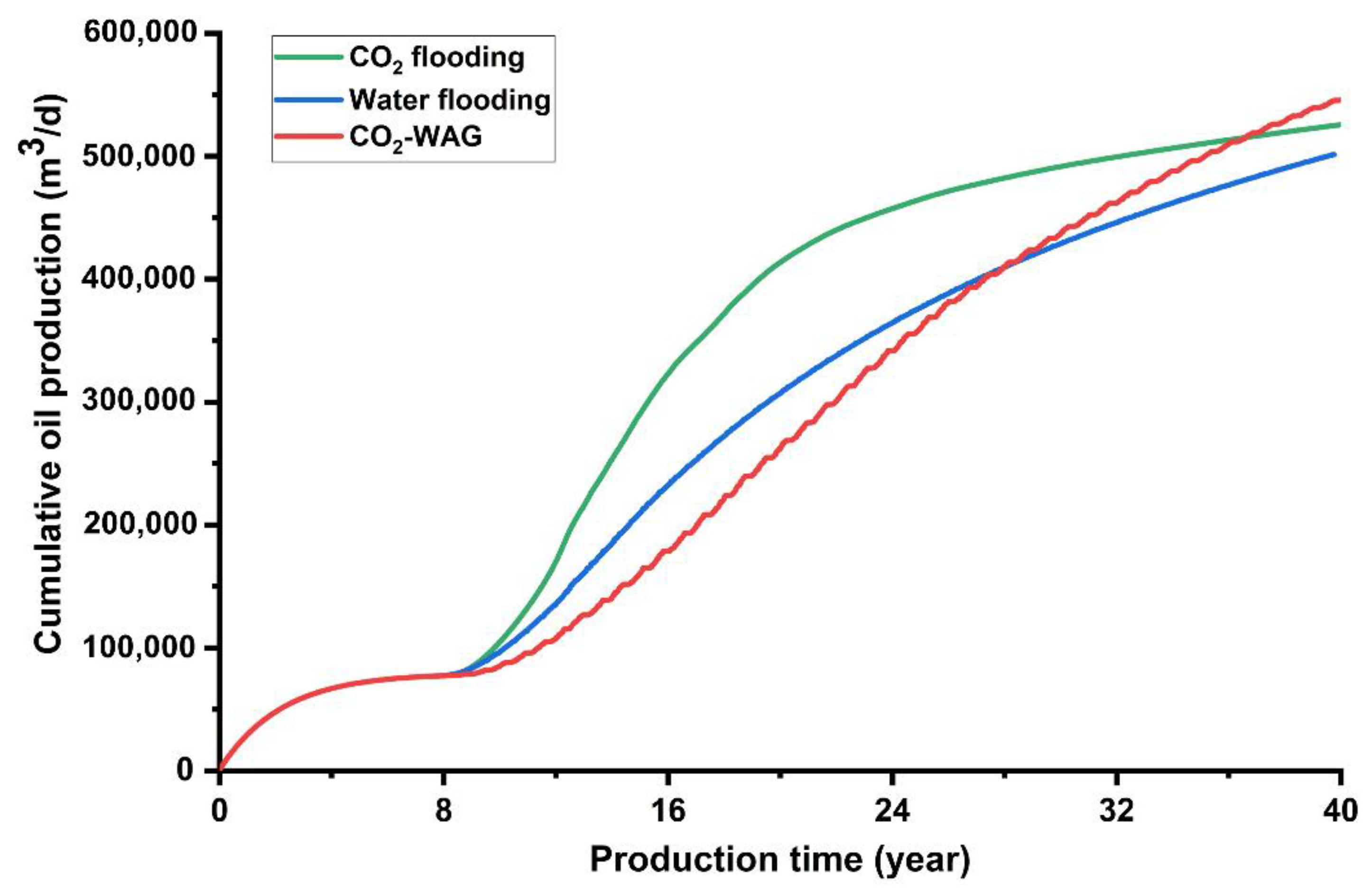


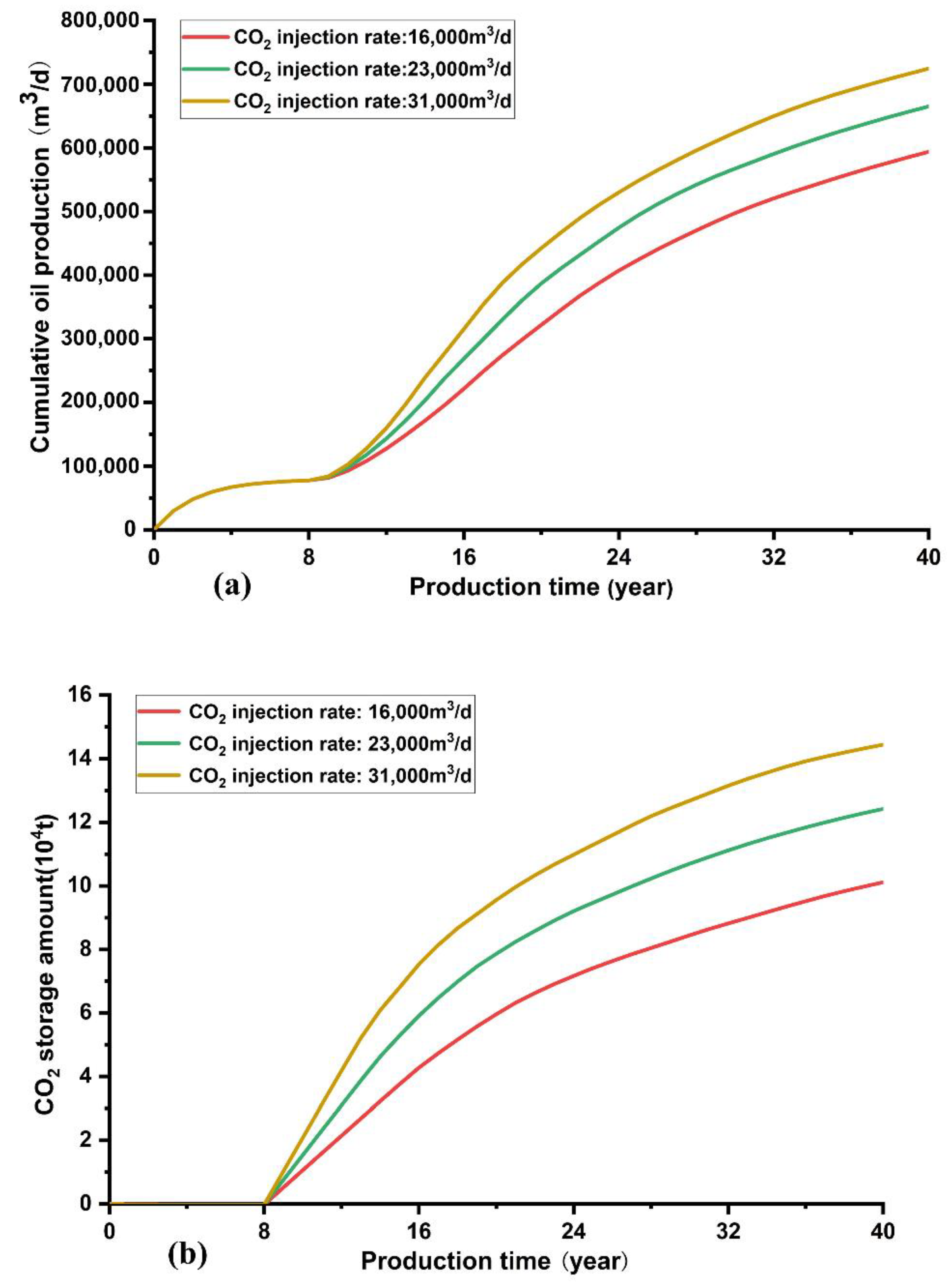
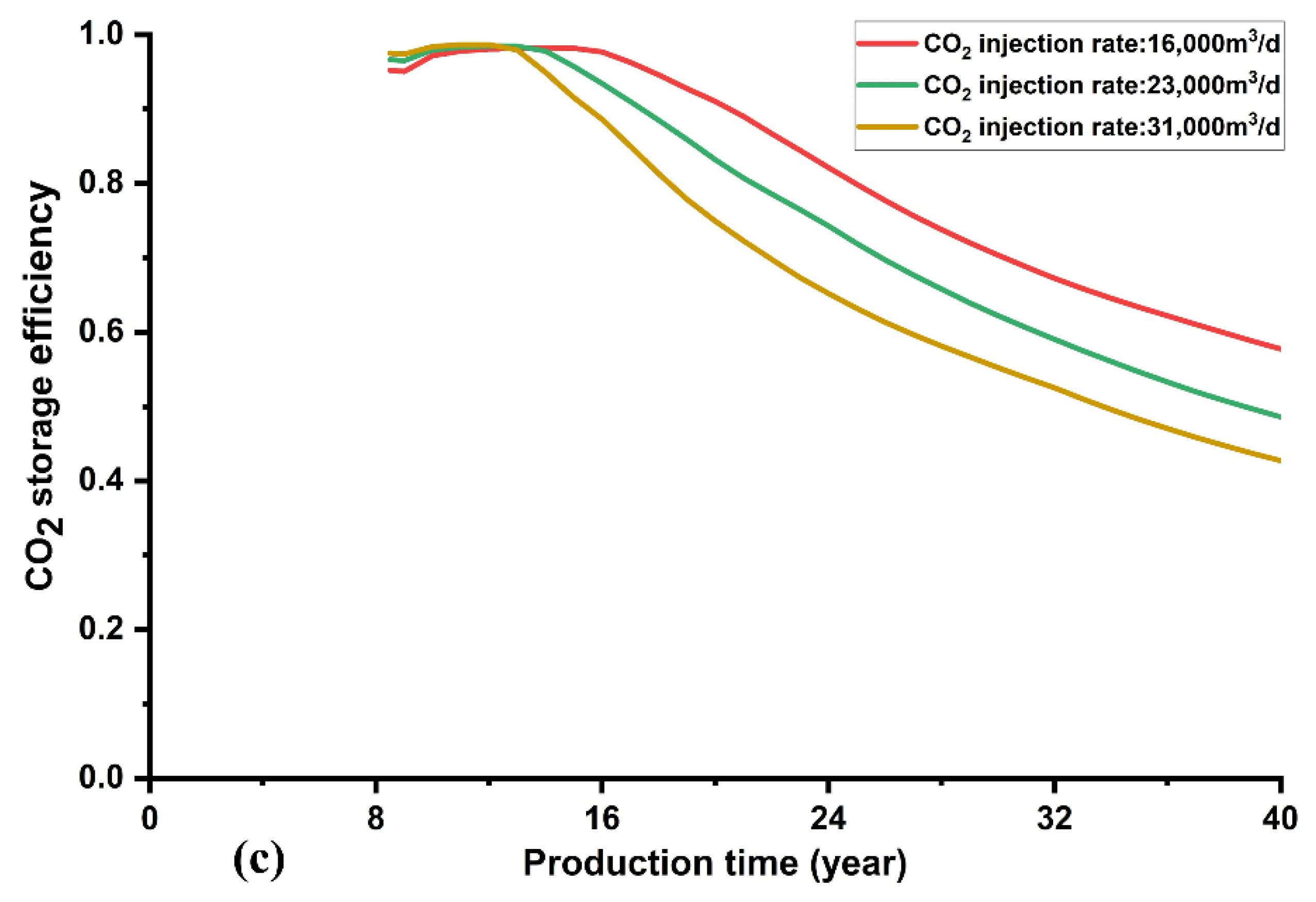
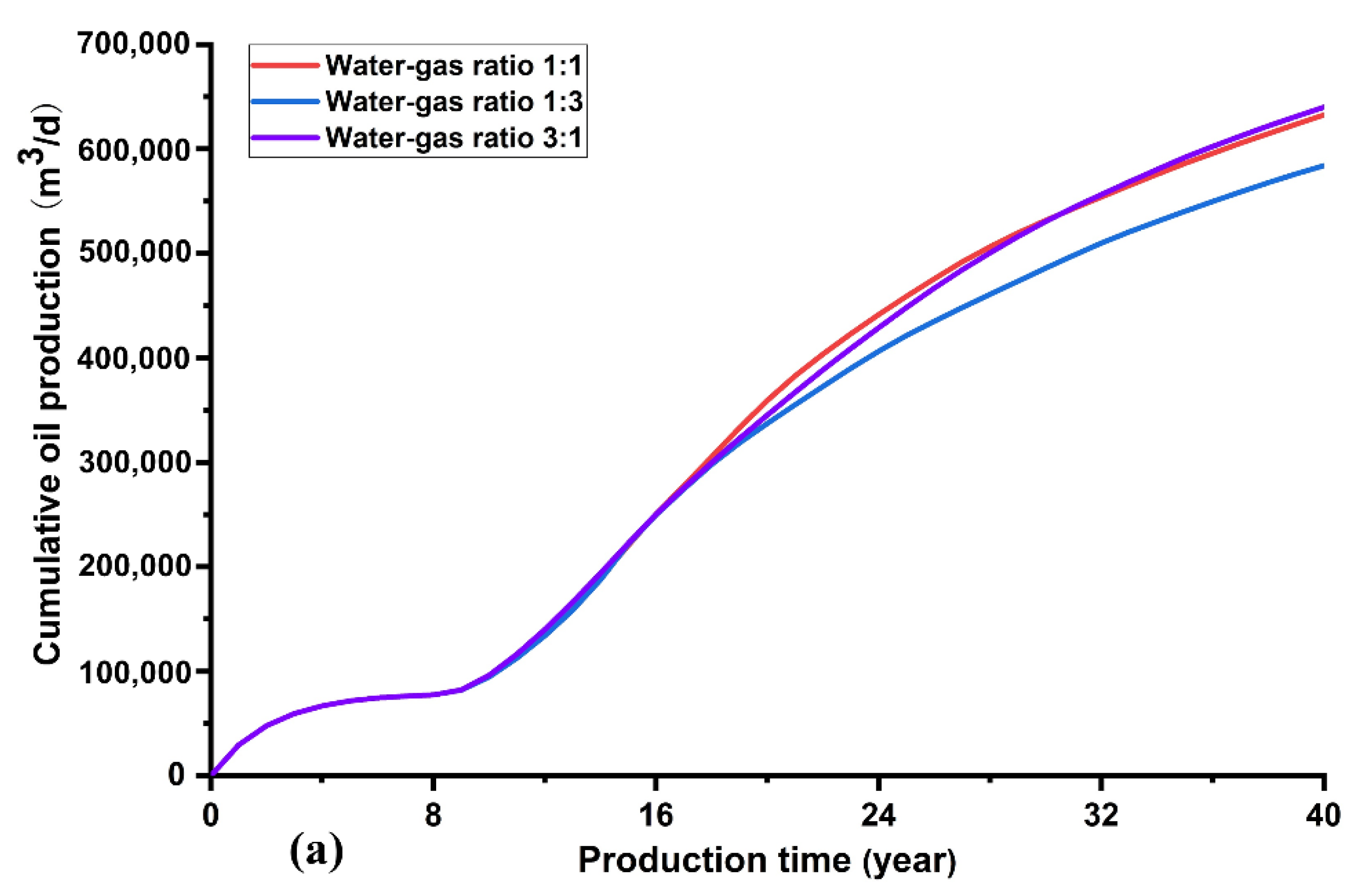
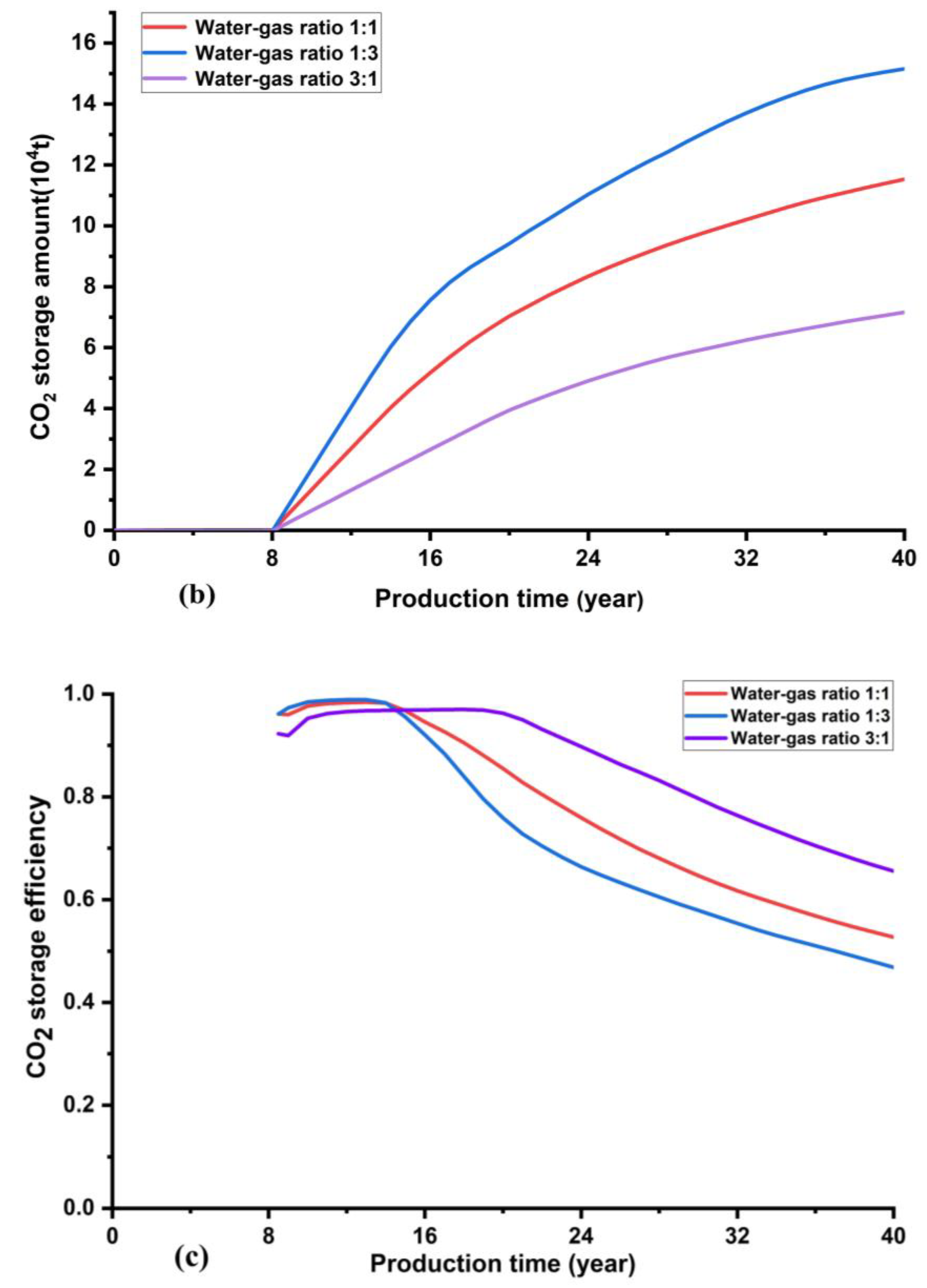

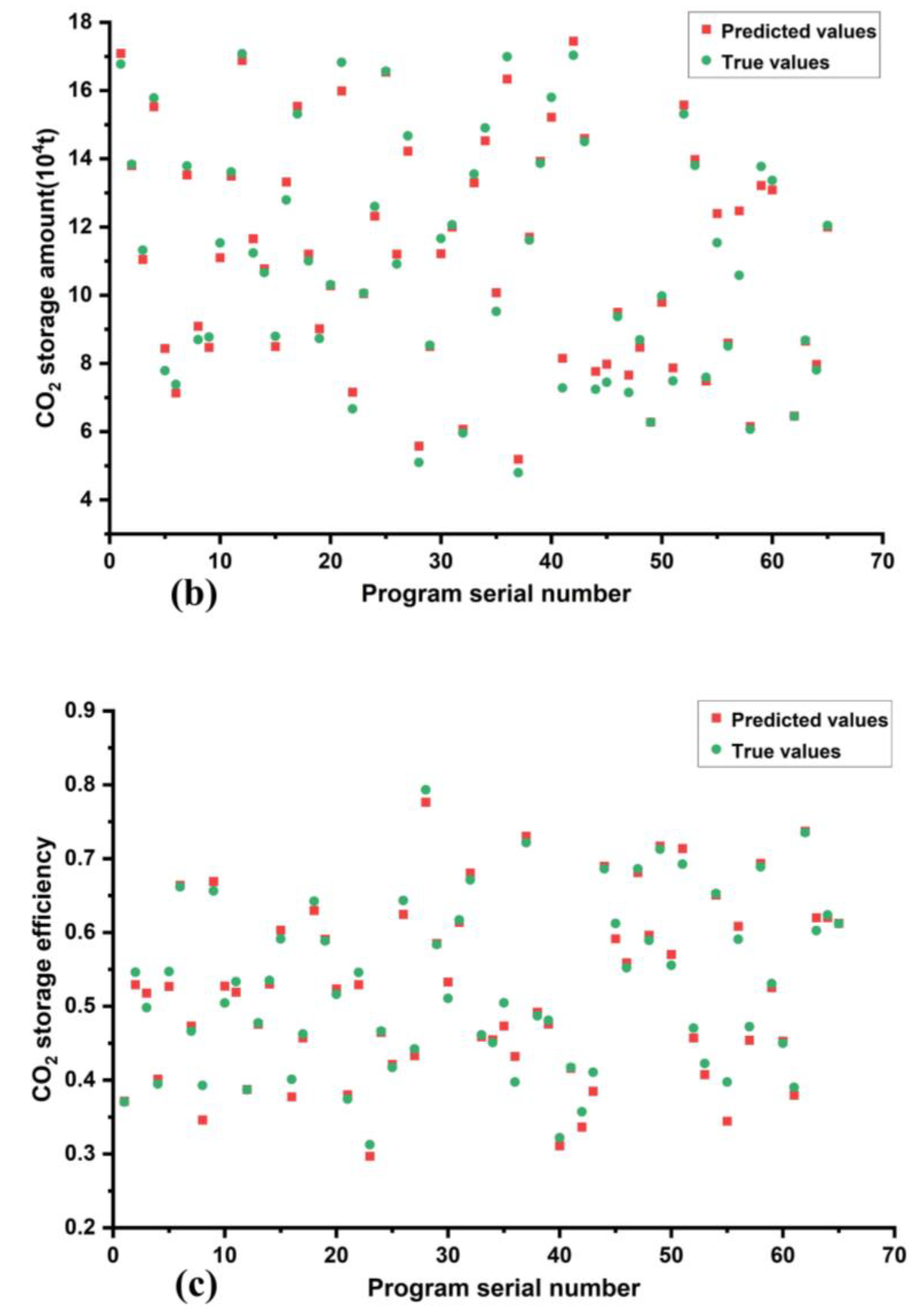
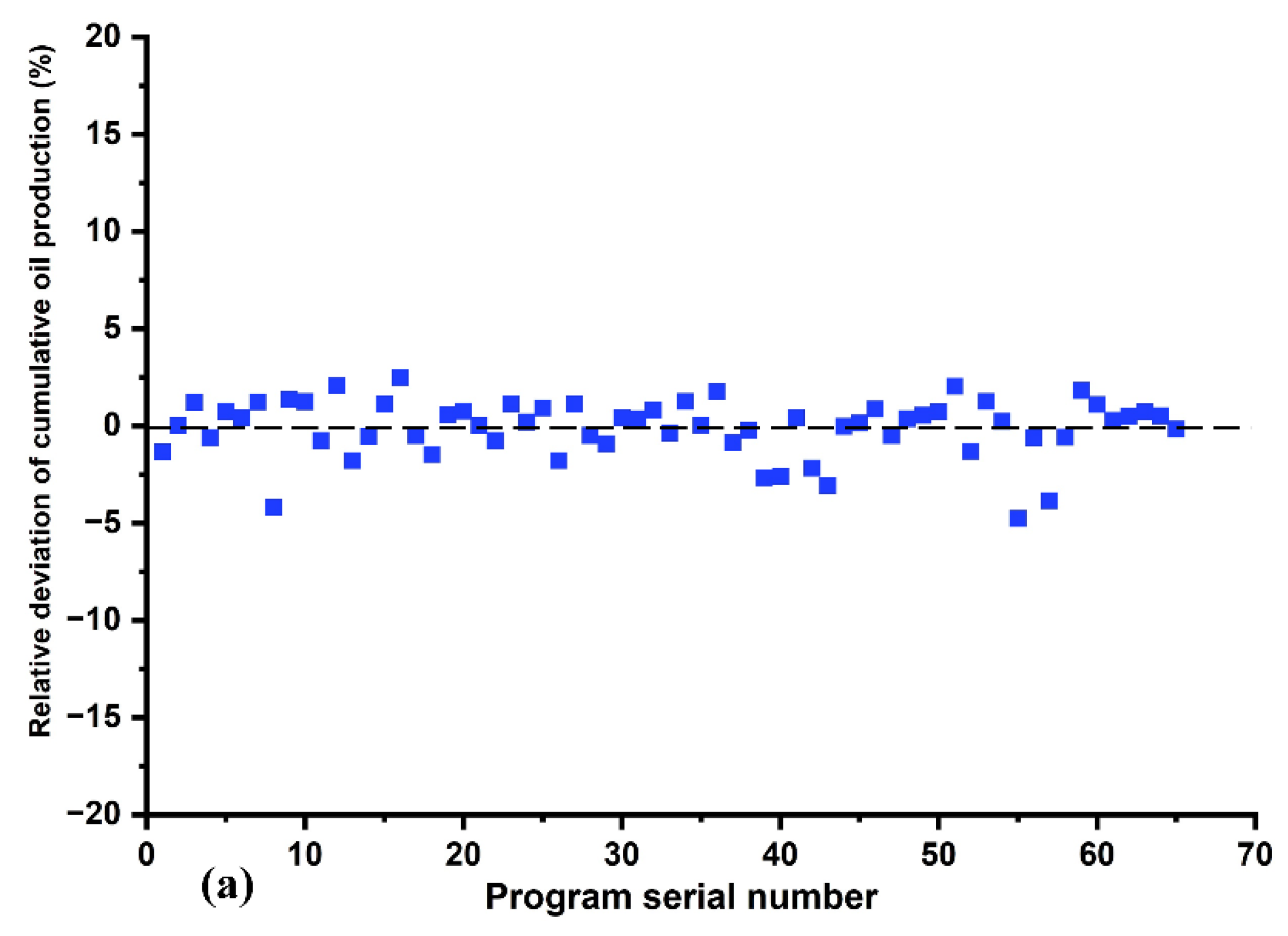
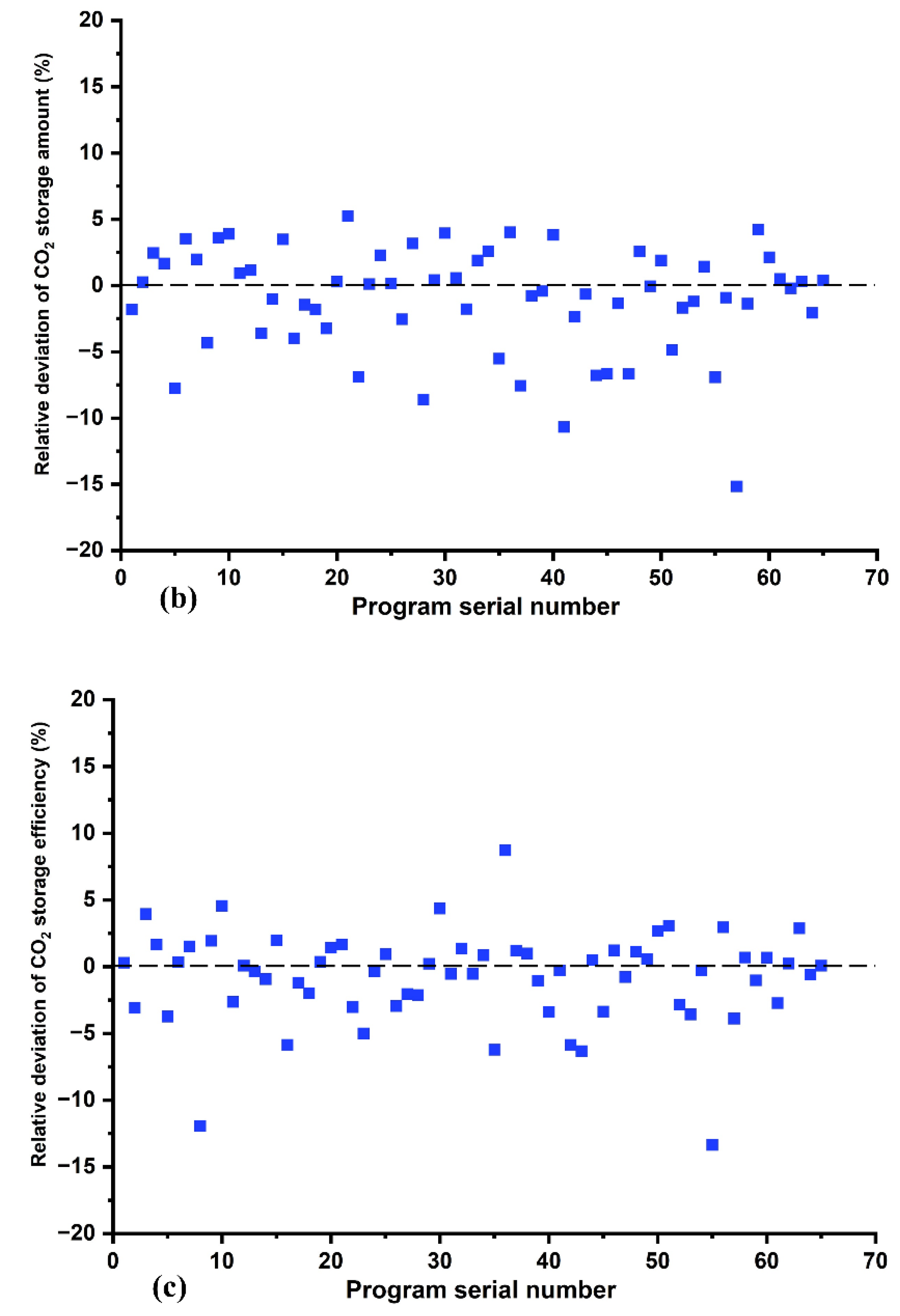
| Serial No. | Input Parameters | Unit | Value |
|---|---|---|---|
| 1 | Average permeability in the X and Y directions | ×10−3 μm3 | 50 |
| 2 | Average permeability in the Z direction | ×10−3 μm3 | 5 |
| 3 | Oil layer thickness | m | 27 |
| 4 | Top depth | m | 1800 |
| 5 | Porosity | 1 | 0.24 |
| 6 | Initial oil saturation | 1 | 0.7934 |
| 7 | Crude oil viscosity | cp | 15.4495 |
| 8 | Crude oil density | kg/m3 | 760.9 |
| 9 | Reservoir temperature | °C | 85 |
| 10 | Initial reservoir pressure | MPa | 18 |
| Layer | Permeability (×10−3 μm3) | |
|---|---|---|
| Horizontal Direction | Vertical Direction | |
| 1 | 10 | 1 |
| 2 | 20 | 2 |
| 3 | 30 | 3 |
| 4 | 40 | 4 |
| 5 | 60 | 6 |
| 6 | 70 | 7 |
| 7 | 80 | 8 |
| 8 | 90 | 9 |
Publisher’s Note: MDPI stays neutral with regard to jurisdictional claims in published maps and institutional affiliations. |
© 2022 by the authors. Licensee MDPI, Basel, Switzerland. This article is an open access article distributed under the terms and conditions of the Creative Commons Attribution (CC BY) license (https://creativecommons.org/licenses/by/4.0/).
Share and Cite
Li, H.; Gong, C.; Liu, S.; Xu, J.; Imani, G. Machine Learning-Assisted Prediction of Oil Production and CO2 Storage Effect in CO2-Water-Alternating-Gas Injection (CO2-WAG). Appl. Sci. 2022, 12, 10958. https://doi.org/10.3390/app122110958
Li H, Gong C, Liu S, Xu J, Imani G. Machine Learning-Assisted Prediction of Oil Production and CO2 Storage Effect in CO2-Water-Alternating-Gas Injection (CO2-WAG). Applied Sciences. 2022; 12(21):10958. https://doi.org/10.3390/app122110958
Chicago/Turabian StyleLi, Hangyu, Changping Gong, Shuyang Liu, Jianchun Xu, and Gloire Imani. 2022. "Machine Learning-Assisted Prediction of Oil Production and CO2 Storage Effect in CO2-Water-Alternating-Gas Injection (CO2-WAG)" Applied Sciences 12, no. 21: 10958. https://doi.org/10.3390/app122110958
APA StyleLi, H., Gong, C., Liu, S., Xu, J., & Imani, G. (2022). Machine Learning-Assisted Prediction of Oil Production and CO2 Storage Effect in CO2-Water-Alternating-Gas Injection (CO2-WAG). Applied Sciences, 12(21), 10958. https://doi.org/10.3390/app122110958







